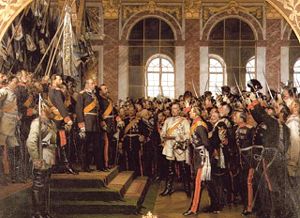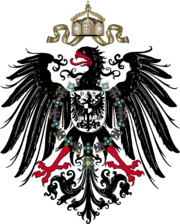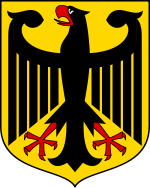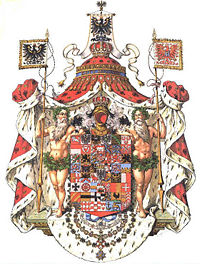Wilhelm I, German Emperor
|
||||||||||||||||||||||||||||||||||

|
||||||||||||||||||||||||||||||||||
Wilhelm I, also known as Wilhelm the Great[1] (William Frederick Louis, German: Wilhelm Friedrich Ludwig) (March 22 1797–March 9 1888) of the House of Hohenzollern was the King of Prussia (January 2 1861–March 9 1888) and the first German Emperor (18 January 1871–March 9 1888).
Under the leadership of Wilhelm and his prime minister Otto von Bismarck, Prussia achieved the unification of Germany and the establishment of the German Empire.
Contents |
Early life and military career
The future king and emperor was born William Frederick Louis of Prussia (Wilhelm Friedrich Ludwig von Preußen) in Berlin. As the second son of King Frederick William III and Louise of Mecklenburg-Strelitz, William was not expected to ascend to the throne and hence received little education.
Wilhelm served in the army from 1814 onward, fought against Napoleon I of France during the Napoleonic Wars, and was reportedly a very brave soldier. He fought under Gebhard Leberecht von Blücher at the Battles of Waterloo and Ligny. He also became an excellent diplomat by engaging in diplomatic missions after 1815.
During the Revolutions of 1848, William successfully crushed a revolt that was aimed at his elder brother King Frederick William IV. The use of cannons made him unpopular at the time and earned him the nickname Kartätschenprinz (Prince of Grapeshot).
In 1857 Frederick William IV suffered a stroke and became mentally disabled for the rest of his life. In January 1858 Wilhelm became Prince Regent for his brother.
King
On January 2 1861 Frederick William died and Wilhelm ascended the throne as Wilhelm I of Prussia. He inherited a conflict between Frederick William and the liberal parliament. He was considered a politically neutral person as he intervened less in politics than his brother. William nevertheless found a conservative solution for the conflict: he appointed Otto von Bismarck to the office of Prime Minister. According to the Prussian constitution, the Prime Minister was responsible solely to the king, not to parliament. Bismarck liked to see his work relationship with Wilhelm as that of a vassal to his feudal superior. Nonetheless it was Bismarck who effectively directed the politics, interior as well as foreign; on several occasions he gained Wilhelm's assent by threatening to resign.
Emperor
In the aftermath of the Franco-Prussian War Wilhelm was proclaimed German Emperor on January 18, 1871 in Versailles Palace. The title "German Emperor" was carefully chosen by Bismarck after discussion until (and after) the day of the proclamation. Wilhelm accepted this title grudgingly as he would have preferred "Emperor of Germany" which, however, was unacceptable to the federated monarchs, and would also have signalled a claim to lands outside of his reign (Austria, Switzerland, Luxemburg etc.). The title "Emperor of the Germans", as proposed in 1848, was ruled out as he considered himself chosen "by the grace of God", not by the people as in a democratic republic.
By this ceremony, the North German Confederation (1867-1871) was transformed into the German Empire ("Kaiserreich", 1871-1918). This Empire was a federal state; the emperor was head of state and president (primus inter pares - first among equals) of the federated monarchs (the kings of Bavaria, Württemberg, Saxony, the grand dukes of Baden, Mecklenburg, Hesse, as well as other principalities, duchies and the senates of the free cities of Hamburg, Lübeck and Bremen).
On May 11 1878, Max Hödel failed in an assassination attempt on Wilhelm in Berlin. A second attempt was made on June 2, 1878, by the anarchist Karl Nobiling, who wounded Wilhelm before committing suicide. These attempts became the pretext for the institution of the Anti-Socialist Law, which was introduced by Bismarck’s government with the support of a majority in the Reichstag in October 18, 1878, for the purpose of fighting the socialist and working-class movement. The laws deprived the Social Democratic Party of Germany of its legal status; they prohibited all organizations, workers’ mass organizations and the socialist and workers’ press, decreed confiscation of socialist literature, and subjected Social-Democrats to reprisals. The laws were extended every 2-3 years. Despite this policy of reprisals the Social Democratic Party increased its influence among the masses. Under pressure of the mass working-class movement the laws were repealed on October 1 1890.
In his memoirs, Bismarck describes Wilhelm as an old-fashioned, courteous, infallibly polite gentleman and a genuine Prussian officer, whose good common sense was occasionally undermined by "female influences".
Full title as German Emperor
|
||||||||||||
His Imperial and Royal Majesty Wilhelm the First, by the Grace of God, German Emperor and King of Prussia, Margrave of Brandenburg, Burgrave of Nuremberg, Count of Hohenzollern, Duke of Silesia and of the County of Glatz, Grand Duke of the Lower Rhine and of Posen, Duke in Saxony, of Angria, of Westphalia, of Pomerania and of Lunenburg, Duke of Schleswig, of Holstein and of Krossen, Duke of Magdeburg, of Brene, of Guelderland and of Jülich, Cleves and Berg, Duke of the Wends and the Kassubes, of Lauenburg and of Mecklenburg, Landgrave of Hesse and in Thuringia, Margrave of Upper and Lower Lusatia, Prince of Orange, of Rugen, of East Friesland, of Paderborn and of Pyrmont, Prince of Halberstadt, of Münster, of Minden, of Osnabrück, of Hildesheim, of Verden, of Kammin, of Fulda, of Nassau and of Moess, Princely Count of Henneberg, Count of the Mark, of Ravensburg, of Hohenstein, of Tecklenburg and of Lingen,Earl of Foxdale, Count of Mansfield, of Sigmaringen and of Veringen, Lord of Frankfurt, etc. [1]
Ancestors
| Wilhelm I, German Emperor | Father: Frederick William III of Prussia |
Father's father: Frederick William II of Prussia |
Father's father's father: Prince Augustus William of Prussia |
| Father's father's mother: Louise Amalie of Brunswick-Lüneburg |
|||
| Father's mother: Frederika Louisa of Hesse-Darmstadt |
Father's mother's father: Louis IX, Landgrave of Hesse-Darmstadt |
||
| Father's mother's mother: Caroline of Zweibrücken |
|||
| Mother: Louise of Mecklenburg-Strelitz |
Mother's father: Charles II, Grand Duke of Mecklenburg-Strelitz |
Mother's father's father: Charles Louis Frederick, Duke of Mecklenburg-Mirow |
|
| Mother's father's mother: Princess Elizabeth Albertine of Saxe-Hildburghausen |
|||
| Mother's mother: Friederike Caroline Luise of Hesse-Darmstadt |
Mother's mother's father: Georg Wilhelm of Hesse-Darmstadt |
||
| Mother's mother's mother: Maria of Leiningen-Dagsburg |
Issue
In 1829, Wilhelm married Augusta of Saxe-Weimar and had two children:
- Frederick III, German Emperor (1831–1888) and
- Princess Louise of Prussia (1838–1923)
Titles, styles, honours and arms
Titles and styles
- 22 March 1797–2 January 1861: His Royal Highness Prince William of Prussia
- 2 January 1861–18 January 1871: His Majesty The King of Prussia
- 18 January 1871–9 March 1888: His Imperial and Royal Majesty The German Emperor, King of Prussia
Books
- Thomas Weiberg: … wie immer Deine Dona. Verlobung und Hochzeit des letzten deutschen Kaiserpaares. Isensee-Verlag, Oldenburg 2007, ISBN 978-3-89995-406-7.
Memorials
From 1867 to 1918 more than 1,000 memorials to Wilhelm I were constructed, including the Kyffhäuser Monument in Thuringia.
See also
- German monarchs family tree. He was related to every other monarch of Germany.
References
- ↑ Ybarra, Thomas R. Wilhelm II. (1921). The Kaiser's Memoirs: Wilhelm II, Emperor Of Germany, 1888-1918. Harper And Brothers Publisher. ISBN 0548323305
External links
- Archontology.org - Wilhelm I
- Willkommen bei preussen.de (German)
- Works by or about Wilhelm I, German Emperor in libraries (WorldCat catalog)
|
Wilhelm I, German Emperor
Born: 22 March 1797 Died: 9 March 1888 |
||
| German nobility | ||
|---|---|---|
| Preceded by Frederick William IV |
King of Prussia 2 January 1861 – 9 March 1888 Prince Regent since 1858 |
Succeeded by Frederick III |
| New creation |
German Emperor 18 January 1871 – 9 March 1888 |
|
| Preceded by Frederick VII of Denmark |
Duke of Lauenburg 1864 – 1888 |
Incorporated into the Prussian crown |
| Vacant
Treaty of Vienna
Title last held by
Frederick VII of Denmark |
Duke of Schleswig and Holstein 1867 – 1888 |
|
| Preceded by Adolphe of Luxembourg as Duke of Nassau |
Prince of Nassau 1866 – 1888 |
|
| Preceded by Frederick William of Hesse as Elector of Hesse |
Landgrave of Hesse Prince of Fulda 1866 – 1888 |
|
| Preceded by Karl Fellner as Elder Mayor of Frankfurt |
Lord of Frankfurt 1866 – 1888 |
|
| Preceded by George V of Hanover as King of Hanover |
Prince of East Friesland, Osnabrück, Hildersheim and Verden Count of Lingen and Tecklenburg 1866 – 1888 |
|
| Political offices | ||
| Preceded by Francis Joseph I of Austria as President of the German Confederation |
President of the North German Confederation 1 July 1867 – 18 January 1871 |
Confederation abolished |
|
||||||||||||||||||||||||||||
|
||||||||||||||
|
||||||||||||||
| German Emperors 18 January 1871 – 9 November 1918 |
||
|---|---|---|
|
Wilhelm I (1871-1888) · Frederick III (1888) · Wilhelm II (1888-1918) |
||
| See also Line of succession to the German throne | ||
| Persondata | |
|---|---|
| NAME | William I |
| ALTERNATIVE NAMES | Ludwig, Wilhelm Friedrich |
| SHORT DESCRIPTION | German Emperor |
| DATE OF BIRTH | March 22 1797 |
| PLACE OF BIRTH | Berlin, Prussia |
| DATE OF DEATH | March 9 1888 |
| PLACE OF DEATH | Berlin, Prussia |



